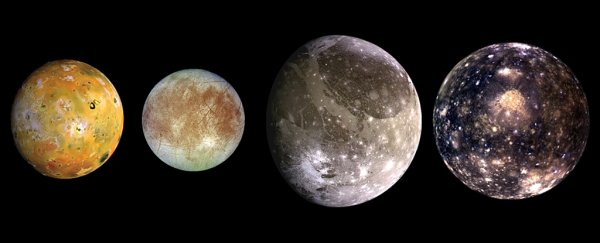Jupiter's moons are hotter than they really should be, some 778 million kilometres (483 million miles) away from the Sun.
It had been thought that most of this extra warmth was provided by Jupiter itself, but now there's a new hypothesis: they're heating each other.
Jupiter isn't acting as a roaring campfire for its surrounding satellites, but because of its huge mass, what it is doing is pushing and pulling its moons – and that generates heat. It's an effect known as tidal heating.
The new model in this latest study looks at moon-to-moon heating, finding that the gravitational interplay that they have with each other could be enough to cause more tidal heating than that of the planet they're orbiting.
"It's surprising because the moons are so much smaller than Jupiter," says planetary scientist Hamish Hay, from the NASA Jet Propulsion Laboratory (JPL). "You wouldn't expect them to be able to create such a large tidal response."
It's hoped that the new discovery will help astronomers learn more about the evolution of Jupiter's moon system as a whole. So far there are at least 79 Jovian moons that we know about. Io, Europa, Ganymede, and Callisto are the largest four.
Scientists think these big four moons are toasty enough to be hiding oceans of liquid water under their surfaces, while Io is hot enough to host more than 400 active volcanoes. So it's clear something is keeping these moons from freezing up in deep space.
Tidal heating works through what's called tidal resonance – these moons are essentially being vibrated at certain frequencies, and it's a phenomenon that happens everywhere there's water, including here on Earth.
"Resonance creates loads more heating," says Hay. "Basically, if you push any object or system and let go, it will wobble at its own natural frequency.
"If you keep on pushing the system at the right frequency, those oscillations get bigger and bigger, just like when you're pushing a swing. If you push the swing at the right time, it goes higher, but get the timing wrong and the swing's motion is dampened."
It's in calculating these natural frequencies that the researchers have made their discovery: the tidal resonances of Jupiter alone don't match the sizes of the oceans thought to be on these moons.
It's only when gravitational forces from the moons themselves are also added in that the tidal forces match current estimates of the moon oceans. The team thinks the overall tidal heating might be enough to melt ice and rock inside the moons.
As always with models like this, there is some informed guesswork – in this case about how stable the tidal resonances are, for example.
However, the researchers say they've now got a good foundation to explore the phenomenon further, and the same approach could help identify likely ocean worlds further out in space.
"Ultimately, we want to understand the source of all this heat, both for its influence on the evolution and habitability of the many worlds across the Solar System and beyond," says planetary scientist Antony Trinh, from the University of Arizona.
The research has been published in Geophysical Research Letters.
